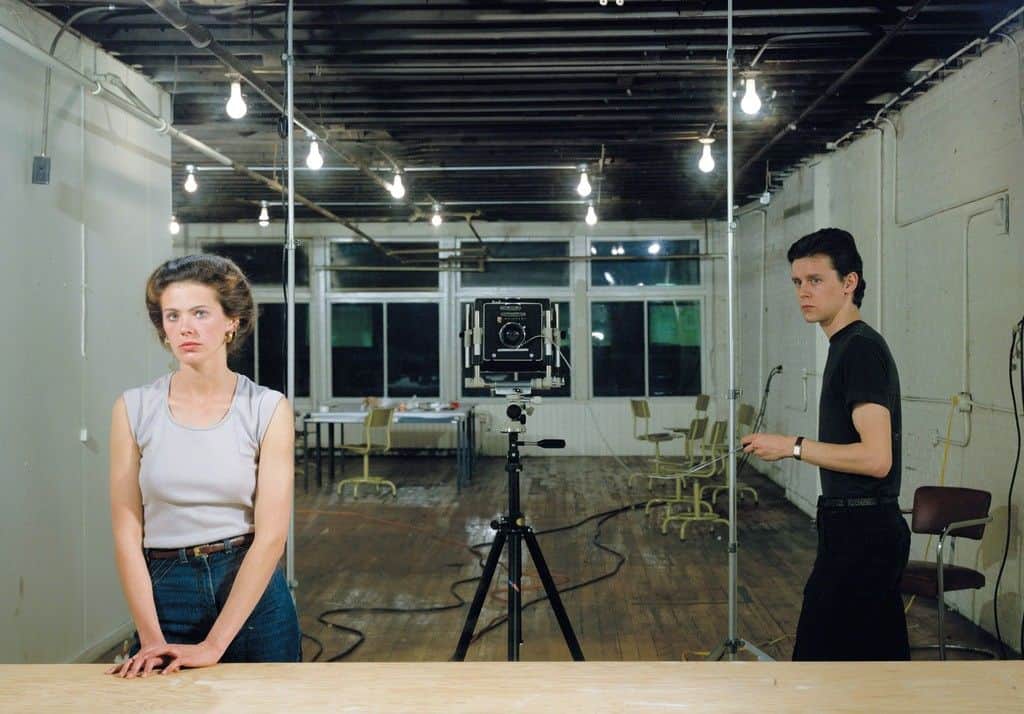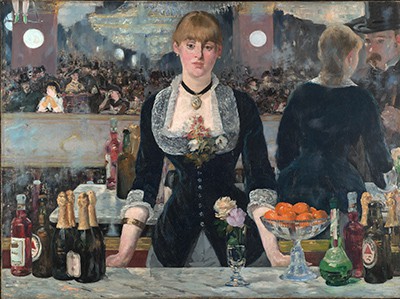Picture for Women is a 1979 photograph by Canadian photographer Jeff Wall. Of large size (63 x 88 in.) it was taken in transparent Cibachrome on a light box. It is kept in Paris, at the Centre Pompidou, under the inventory number AM 1987-1135.
The foreground of the image shows the photographer himself on the right, triggering a large format camera with a shutter release cable. The image of the photographer and that of the camera (which occupies the central area of the frame) seem to be reflected and sent back to us by a large mirror that spreads out over the entire area of one of the walls delimiting the room. A young woman is standing to the left of the image, in an enigmatic, conventional pose, her gaze directed towards the camera lens. The presence of two vertical bars visually divides the image into three parts, as if it were a triptych.

The scene takes place in a long room with parquet flooring. Chairs can be seen in the background, and a work table is placed in the background, close to a long radiator topped by windows. The environment is reminiscent of a classroom in an educational institution. The rough plaster walls show the electrical installation. Several light bulbs are installed on the ceiling in a regular arrangement, illuminating the room homogeneously, structuring with their light the depth of the image [3]. We witness a kind of “carefully orchestrated” [1] play of glances, that of the photographer who triggers the shutter, that of the woman posing while looking at the lens (and thus looking at us), and also the “gaze” of the camera, placed on her tripod in the center of the image.
Jeff Wall Picture for Women, context
This image, as indicated by the author, was inspired by the painting Un bar aux Folies Bergère (1881-1882) [2] . In this painting by Manet, kept at the Courtauld Institute in London, we see a waitress behind the bar during an evening at the Folies Bergère. A mirror behind her reflects her image, as well as the image of the public, and also that of the artist on the other side of the counter, to the right of the picture.

At first glance, everything seems to indicate that Wall made his photo according to a spatial organization close to that of Manet. However, a careful look reveals anomalies that call into question this first reading. Indeed, while the photographer admits the presence of a single image on the photo (the image reflected by the mirror), two images are expected for the young woman: the one taken directly through the lens, and the one that would be reflected in the mirror. However, the mirror does not reflect a second image for the woman, nor does it reflect the long counter that serves as a support for the model. Moreover, the lighting chosen for the foreground of the image makes a break with the light that seems to illuminate the room: on the faces of the characters, on the folds of the clothes, we notice for this foreground of the image the presence of lighting placed at the top left of the room, and we can see the cable that feeds this artificial lighting, going up through the pillar on the left of the image.
These observations question us on the veracity of the image, which however seemed indisputable. The original print, preserved at the Centre Pompidou, clearly shows a line of discontinuity that crosses the frame from top to bottom, passing through the camera lens in the middle of the image. This line of discontinuity suggests the possibility of a montage, although this was not indicated by the artist. On the other hand, and as indicated by the artist, this discontinuity in the middle of the frame brings the viewer back to the physical surface of the image, establishing a dialectic between depth and flatness.
More likely, one can think that the totality of the image, including the young woman and the counter, is composed of the reflection coming from the mirror. We would therefore be faced with an entirely specular image, in which all the objects and characters would have been captured indirectly by the camera, according to the reflections coming from the mirror.
Without trying to completely detect the device set up by the artist, it is obvious that he succeeds in obtaining an image capable of questioning our capacity of perception in its usual functioning.
In relation to the format, Wall chooses a very large size, and a transparent presentation on a light box. In fact, as Fried points out, “the late 1970s and the following decade saw the rise of an art photography that was not only produced on a large scale, but also, as Jean-François Chevrier was the first to point out, was intended for the wall” [4].
The mechanisms of eroticism
From a socio-cultural point of view, and following the interpretation of J.F. Chevrier, Picture for Woman problematizes the male-female relationship. This relationship is however not told from the point of view of the alienation of Parisian bars at the end of the 19th century, as in Manet’s painting. Indeed, the Folies Bergère theatre was a place of gallantry and luxury prostitution, reducing the woman to an object.
On the contrary, in Wall’s photographic painting, it is the camera that is placed in the center of the image, occupying the place of the female model. The man’s gaze is directed towards the woman through the machine, leaving the man in the service of the latter. The woman, as for her, as we know, turns her back on the photographer. Her gaze is directed towards the spectator in an attitude of independence. She is an actress (performer), a conscious protagonist of the scene (and not absent, as with Manet).
In Picture for Women, the photographic action takes place within a classroom in the academic institution. With this Jeff Wall shows a pedagogical concern which, by passing through art history, awakens our perception to focus on the problem of the sensual male-female bond. Indeed, the artist had indicated, about Picture for Women, that it is a “course on the mechanisms of eroticism” [5].
Picture for Women is one of Jeff Wall’s first large format prints, from which the artist presents a scholarly, pictorial photograph in constant dialogue with the history of art. As is common with Wall, this work lends itself to several readings and interpretations, in a complex register. A work with a pedagogical vocation, it shares with us the artistic tradition regarding the representation of women, whose role has evolved during the 20th century, in search of independence and autonomy. Picture for Women also challenges our capacity of observation, and questions the role of photography as a witness of reality.
In this sense, it is not a “documental” photography that is advocated by Wall, but rather a photographic art that revolves around representation, with a narrative substrate that brings it closer to cinema. Wall’s photographic paintings take a critical look at social experience, considering the complexity of individuals in their relationships with others, others being understood as a reflection of oneself.
[1] Michael FRIED, Why Photography Matter as Art as Never Before, Yale University Press, 2008, p.17
[2] https://www.centrepompidou.fr/cpv/resource/c5eBM7k/rGBRrRM
[3] “The join between the two pictures brings your eye up to the surface again and creates a dialectic that I always enjoyed and learned from painting…a dialectic between depth and flatness. Sometimes I hide it, sometimes I don’t”. Jeff Wall, guide room 1, Tate Museum, http://www.tate.org.uk/whats-on/tate-modern/exhibition/jeff-wall/room-guide/jeff-wall-room-1
[4] Michael FRIED, Why Photography Matter as Art as Never Before, Yale University Press, 2008, p.2
[5] Naomi MERRIT, “Manet’s Mirror and Jeff Wall’s Picture for Women: Reflection or Refraction?” Melbourne art journal, issue 4, 2009
Curated videos, Jeff Wall, Picture for Women
Curated links, Jeff Wall Picture for Women
https://emajartjournal.files.wordpress.com/2012/08/merritt.pdf
Great picture! It looked so simple at first glance though…